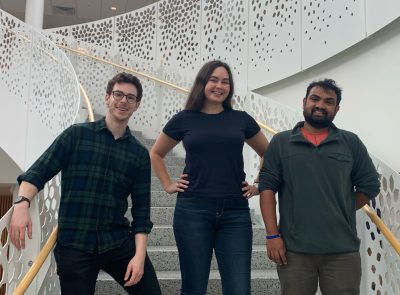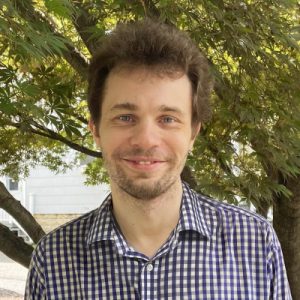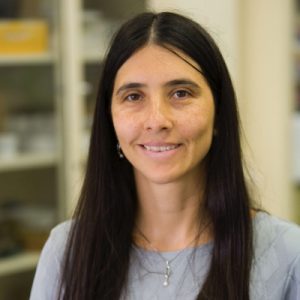Two of UConn Physics Department’s undergrads, Rachel Cleveland and Nicholas Thiel-Hudson, have been recently selected as part of the 2024 cohort of UConn University Scholars! These students were selected based on the strength of their proposal. Graduation as a University Scholar recognizes a student’s extraordinary engagement with self-reflective learning and research or creative endeavors.
Rachel Cleveland
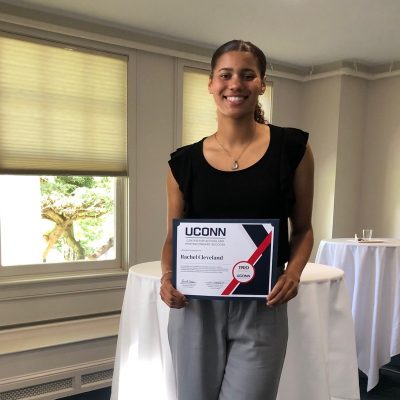
Major: Physics
Project Title: Determining the Parameters that Drive the Co-evolution of Black Holes and Galaxies
Committee: Daniel Angles-Alcazar, Physics; Cara Battersby, Physics; Lea Ferreira dos Santos, Physics
Project Summary: Cosmological simulations are incredibly useful tools for astrophysicists. They allow a deeper exploration of celestial phenomena and reveal their intricate workings. In the past, I have observed patterns between black holes and their host galaxies using SIMBA simulations. I now plan to enhance my research by transitioning to the CAMELS simulation. This offers the flexibility to manipulate various cosmological parameters, which brings the promise of uncovering the fundamental drivers behind my previously observed trends. This endeavor will help advance our understanding of the cosmos.
Rachel Cleveland is a junior honors student from Windsor, CT pursuing a major in Physics and a minor in Mathematics and Statistics. She is a McNair Scholar, Presidential Scholar, and Babbidge Scholar at UConn. She plans to attend a PhD program after graduation.
Nicholas Thiel-Hudson
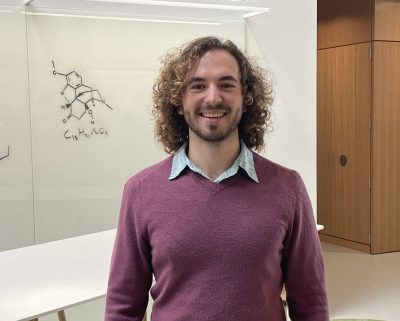
Major: Physics and Music
Project title: Rare-Earth Manganites for CO2 Reduction and Quantum Sensing
Committee: Dr. Menka Jain, Physics; Dr. Peter Schweitzer, Physics; and Dr. Ronald Squibbs, Music
Project Summary: Lanthanum strontium manganite (LSMO) is a solid-state material that exhibits particularly interesting electrical and magnetic properties. This makes LSMO a good candidate for use in advanced technologies, however, it is very difficult to make. This project will investigate novel synthesis methods to fabricate LSMO powders and films for two different applications. Powders will be optimized for use as a selective electrocatalyst in the conversion of carbon dioxide into usable hydrocarbon products. Films will be optimized for use in quantum sensing, which is useful for advanced technologies.
Nicholas Thiel-Hudson, from New Fairfield, CT, is a Presidential Scholar pursuing dual degrees in Physics and Music. In his free time, he enjoys playing the violin and listening to music from around the world. Nicholas is also an avid weightlifter and occasional rock climber.
For the list of all 2024 University Scholars, visit University Scholars Program website.
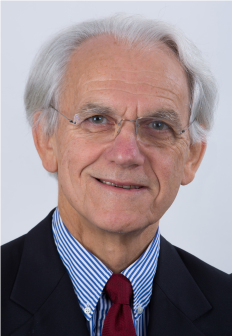 Gérard Mourou received his undergraduate education at the University of Grenoble (1967) and his Ph.D. from University Paris VI in 1973. He has made numerous contributions to the field of ultrafast lasers, high-speed electronics, and medicine. But, his most important invention, demonstrated with his student Donna Strickland while at the University of Rochester (N.Y.), is the laser amplification technique known as Chirped Pulse Amplification (CPA), universally used today. CPA revolutionized the field of optics, opening new branches like attosecond pulse generation, Nonlinear QED, and compact particle accelerators. It extended the field of optics to nuclear and particle physics. In 2005, Prof. Mourou proposed a new infrastructure, the Extreme Light Infrastructure (ELI), which is distributed over three pillars located in the Czech Republic, Romania, and Hungary. Prof. Mourou also pioneered the field of femtosecond ophthalmology that relies on a CPA femtosecond laser for precise myopia corrections and corneal transplants. Over a million such procedures are now performed annually. Prof. Mourou is a member of the U.S. National Academy of Engineering, and a foreign member of the Russian Science Academy, the Austrian Sciences Academy, and the Lombardy Academy for Sciences and Letters. He is Chevalier de la Légion d’honneur.
Gérard Mourou received his undergraduate education at the University of Grenoble (1967) and his Ph.D. from University Paris VI in 1973. He has made numerous contributions to the field of ultrafast lasers, high-speed electronics, and medicine. But, his most important invention, demonstrated with his student Donna Strickland while at the University of Rochester (N.Y.), is the laser amplification technique known as Chirped Pulse Amplification (CPA), universally used today. CPA revolutionized the field of optics, opening new branches like attosecond pulse generation, Nonlinear QED, and compact particle accelerators. It extended the field of optics to nuclear and particle physics. In 2005, Prof. Mourou proposed a new infrastructure, the Extreme Light Infrastructure (ELI), which is distributed over three pillars located in the Czech Republic, Romania, and Hungary. Prof. Mourou also pioneered the field of femtosecond ophthalmology that relies on a CPA femtosecond laser for precise myopia corrections and corneal transplants. Over a million such procedures are now performed annually. Prof. Mourou is a member of the U.S. National Academy of Engineering, and a foreign member of the Russian Science Academy, the Austrian Sciences Academy, and the Lombardy Academy for Sciences and Letters. He is Chevalier de la Légion d’honneur.